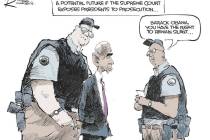Schools could use lessons in efficiency
In Nevada, as across the nation, ambitious efforts are under way to improve K-12 schooling. In a state where graduation rates are among the nation's lowest, and where reading and math performance lags the national average, these measures are crucial. Policymakers are seeking to identify and recognize terrific teachers, promote school accountability and address low-performing schools.
When it comes to making these efforts pay off in Clark County, two challenges loom large. First, state-level policies tend to be blunt and prescriptive. This can lead to pushback or frustration. Second, these reforms depend mightily on whether school and system leaders employ them wisely and well.
For instance, efforts to give schools more flexibility or embrace more performance-based teacher evaluations pay off only if leaders use their new authority, and do so in thoughtful ways. Too often in the past, this has not happened.
In understanding why it hasn't, there are two rules of thumb worth keeping in mind. First, to paraphrase Mark Twain, rumors of what K-12 leaders cannot do are greatly exaggerated. Second, K-12 leaders who find smart ways to save money or use their staff face blowback from disgruntled employees while rarely getting much support or recognition from their supervisors or the community.
Leaders, too, rarely get the training or support that equips them to lead boldly. Most education leadership training programs devote the whole of their attention to culture, coaching and collaboration while dismissing challenges like regulation or lassitude. Principals and superintendents almost uniformly start their careers as classroom teachers, spend their working lives in K-12 and receive all of their leadership training in schools of education. As a result, leaders have little experience outside of K-12 schooling and lack the opportunity to learn how challenges like budgeting, accountability, personnel evaluation or compensation are tackled elsewhere.
As I argue in my new book, "Cage-Busting Leadership," school systems need leaders who are skilled in curriculum and instruction, but equally able to help schools use time, talent, tools and money in better, smarter ways. Asking educators to excel, even as schools make poor use of instructional time and staff, is a recipe for stagnation.
To take one example: Leaders need to ask whether they're squeezing all the juice out of the team they have. We know from time diaries that about 35 percent of the typical teacher's day is spent on tasks other than instruction - on assemblies, celebrations, attendance, paperwork, class disruptions and the rest. Can a leader reduce this by half? Doing so would boost each student's instructional time by more than 100 hours a year.
Here's how this can play out locally. The Clark County School District is adopting a new student information system that will give the typical teacher more than 30 hours a year, because they'll have to enter student data in fewer systems and they'll be able to access student information more rapidly. This is like adding an extra week of instruction each year for free - or, it's the equivalent of adding another 50 teachers to district schools.
School districts also need to rethink how they spend scarce funds. In Washington, D.C., Chancellor Kaya Henderson identified $10 million in cost savings to launch a competitive "Proving What's Possible Fund" that supports school-level efforts to use time or talent in smarter ways. The funds were repurposed from existing sources. She explains the system was funding lots of interventions people liked, "But when you looked at the results, they were uneven at best."
Today, it's fairly easy to find out how well a school is faring academically, but it's difficult to gauge bang for the buck. Consequently, school and system leaders focus on boosting achievement but pay far less attention to cost-effectiveness. And, given that zeroing out programs or trimming expenditures is sure to anger someone, while unlikely to garner much popular notice, it's no surprise that system leaders and principals rarely pursue efficiencies in spending and staff. Yet, getting the same achievement results for 10 percent less frees up millions of dollars to put in programs, staff and practices that can drive improvement.
The Clark County School District's recently launched "Open Book" Web portal, which throws open its financial data for the whole world to see, is such a promising sign because it holds out hope of major progress on this count.
The Clark County School District, with its massive size, academic challenges and tight budget sorely needs cage-busting leadership. But that leadership will succeed only if the community recognizes and supports cage-busting leaders and has the patience and confidence that give these leaders a chance to succeed. Whether the community does so is the key to the future of school improvement in Clark County.
Frederick M. Hess is director of education policy studies at the American Enterprise Institute, a fellow with the Las Vegas-based Public Education Foundation and author of "Cage-Busting Leadership" (Harvard Education Press, 2013).























